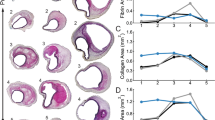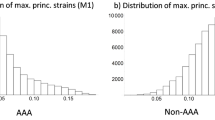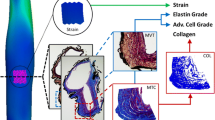Abstract
We recently developed an approach to characterize local nonlinear, anisotropic mechanical properties of murine arteries by combining biaxial extension–distension testing, panoramic digital image correlation, and an inverse method based on the principle of virtual power. This experimental–computational approach was illustrated for the normal murine abdominal aorta assuming uniform wall thickness. Here, however, we extend our prior approach by adding an optical coherence tomography (OCT) imaging system that permits local reconstructions of wall thickness. This multimodality approach is then used to characterize spatial variations of material and structural properties in ascending thoracic aortic aneurysms (aTAA) from two genetically modified mouse models (fibrillin-1 and fibulin-4 deficient) and to compare them with those from angiotensin II-infused apolipoprotein E-deficient and wild-type control ascending aortas. Local values of stored elastic energy and biaxial material stiffness, computed from spatial distributions of the best fit material parameters, varied significantly with circumferential position (inner vs. outer curvature, ventral vs. dorsal sides) across genotypes and treatments. Importantly, these data reveal an inverse relationship between material stiffness and wall thickness that underlies a general linear relationship between stiffness and wall stress across aTAAs. OCT images also revealed sites of advanced medial degeneration, which were captured by the inverse material characterization. Quantification of histological data further provided high-resolution local correlations among multiple mechanical metrics and wall microstructure. This is the first time that such structural defects and local properties have been characterized mechanically, which can better inform computational models of aortopathy that seek to predict where dissection or rupture may initiate.





Similar content being viewed by others
References
Alreshidan M, Shahmansouri N, Chung J et al (2017) Obtaining the biomechanical behavior of ascending aortic aneurysm via the use of novel speckle tracking echocardiography. J Thorac Cardiovasc Surg 153:781–788. https://doi.org/10.1016/j.jtcvs.2016.11.056
Avril S, Badel P, Duprey A (2010) Anisotropic and hyperelastic identification of in vitro human arteries from full-field optical measurements. J Biomech 43:2978–2985. https://doi.org/10.1016/j.jbiomech.2010.07.004
Aylward SR, Bullitt E (2002) Initialization, noise, singularities, and scale in height ridge traversal for tubular object centerline extraction. IEEE Trans Med Imaging 21:61–75. https://doi.org/10.1109/42.993126
Bellini C, Ferruzzi J, Roccabianca S et al (2014) A microstructurally motivated model of arterial wall mechanics with mechanobiological implications. Ann Biomed Eng 42:488–502. https://doi.org/10.1007/s10439-013-0928-x
Bellini C, Bersi MR, Caulk AW et al (2017) Comparison of 10 murine models reveals a distinct biomechanical phenotype in thoracic aortic aneurysms. J R Soc Interface 14:20161036. https://doi.org/10.1098/rsif.2016.1036
Bersi MR, Bellini C, Di Achille P et al (2016a) Novel methodology for characterizing regional variations in material properties of murine aortas. J Biomech Eng 138:1–15. https://doi.org/10.1115/1.4033674
Bersi MR, Bellini C, Wu J et al (2016b) Excessive adventitial remodeling leads to early aortic maladaptation in angiotensin-induced hypertension. Hypertension 67:890–896. https://doi.org/10.1161/HYPERTENSIONAHA.115.06262
Bersi MR, Khosravi R, Wujciak AJ et al (2017) Differential cell-matrix mechanoadaptations and inflammation drive regional propensities to aortic fibrosis, aneurysm or dissection in hypertension. J R Soc Interface 14:1–31. https://doi.org/10.1098/rsif.2017.0327
Bürk J, Blanke P, Stankovic Z et al (2012) Evaluation of 3D blood flow patterns and wall shear stress in the normal and dilated thoracic aorta using flow-sensitive 4D CMR. J Cardiovasc Magn Reson 14:1–11. https://doi.org/10.1186/1532-429X-14-84
Choudhury N, Bouchot O, Rouleau L et al (2009) Local mechanical and structural properties of healthy and diseased human ascending aorta tissue. Cardiovasc Pathol 18:83–91. https://doi.org/10.1016/j.carpath.2008.01.001
Cook JR, Clayton NP, Carta L et al (2015) Dimorphic effects of transforming growth factor-β signaling during aortic aneurysm progression in mice suggest a combinatorial therapy for Marfan syndrome. Arterioscler Thromb Vasc Biol. https://doi.org/10.1161/ATVBAHA.114.305150
de Wit A, Vis K, Jeremy RW (2013) Aortic stiffness in heritable aortopathies: relationship to aneurysm growth rate. Heart Lung Circ 22:3–11. https://doi.org/10.1016/j.hlc.2012.08.049
Duprey A, Trabelsi O, Vola M et al (2016) Biaxial rupture properties of ascending thoracic aortic aneurysms. Acta Biomater 42:273–285. https://doi.org/10.1016/j.actbio.2016.06.028
Elefteriades JA (2008) Thoracic aortic aneurysm: reading the enemy’s playbook. Curr Probl Cardiol 33:203–277. https://doi.org/10.1016/j.cpcardiol.2008.01.004
Faury G (2001) Function-structure relationship of elastic arteries in evolution: From microfibrils to elastin and elastic fibres. Pathol Biol 49:310–325. https://doi.org/10.1016/S0369-8114(01)00147-X
Fedorov A, Beichel R, Kalpathy-Cramer J et al (2012) 3D slicer as an image computing platform for the quantitative imaging network. Magn Reson Imaging 30:1323–1341. https://doi.org/10.1016/j.mri.2012.05.001
Ferruzzi J, Collins MJ, Yeh AT, Humphrey JD (2011) Mechanical assessment of elastin integrity in fibrillin-1-deficient carotid arteries: implications for Marfan syndrome. Cardiovasc Res 92:287–295. https://doi.org/10.1093/cvr/cvr195
Ferruzzi J, Bersi MR, Humphrey JD (2013) Biomechanical phenotyping of central arteries in health and disease: advantages of and methods for murine models. Ann Biomed Eng 41:1311–1330. https://doi.org/10.1007/s10439-013-0799-1
Ferruzzi J, Bersi MR, Uman S et al (2015) Decreased elastic energy storage, not increased material stiffness, characterizes central artery dysfunction in fibulin-5 deficiency independent of sex. J Biomech Eng 137:31007. https://doi.org/10.1115/1.4029431
Ferruzzi J, Murtada SI, Li G et al (2016) Pharmacologically improved contractility protects against aortic dissection in mice with disrupted transforming growth factor-beta signaling despite compromised extracellular matrix properties. Arterioscler Thromb Vasc Biol 36:919–927. https://doi.org/10.1161/ATVBAHA.116.307436
Fung YC (1967) Elasticity of soft tissues in simple elongation. Am J Physiol 213:1532–1544
Genovese K (2009) A video-optical system for time-resolved whole-body measurement on vascular segments. Opt Lasers Eng 47:995–1008. https://doi.org/10.1016/j.optlaseng.2009.04.017
Genovese K, Lee Y-U, Lee AY, Humphrey JD (2013) An improved panoramic digital image correlation method for vascular strain analysis and material characterization. J Mech Behav Biomed Mater 27:132–142. https://doi.org/10.1016/j.jmbbm.2012.11.015
Gleason RL, Gray SP, Wilson E, Humphrey JD (2004) A multiaxial computer-controlled organ culture and biomechanical device for mouse carotid arteries. J Biomech Eng 126:787. https://doi.org/10.1115/1.1824130
Gomez D, Al Haj Zen A, Borges LF et al (2009) Syndromic and non-syndromic aneurysms of the human ascending aorta share activation of the Smad2 pathway. J Pathol 218:131–142. https://doi.org/10.1002/path.2516
Hatzaras I, Tranquilli M, Coady M et al (2007) Weight lifting and aortic dissection: more evidence for a connection. Cardiology 107:103–106. https://doi.org/10.1159/000094530
Hentschke H, Stüttgen MC (2011) Computation of measures of effect size for neuroscience data sets. Eur J Neurosci 34:1887–1894. https://doi.org/10.1111/j.1460-9568.2011.07902.x
Huang J, Davis EC, Chapman SL et al (2010) Fibulin-4 deficiency results in ascending aortic aneurysms: a potential link between abnormal smooth muscle cell phenotype and aneurysm progression. Circ Res 106:583–592. https://doi.org/10.1161/CIRCRESAHA.109.207852
Huang J, Yamashiro Y, Papke CL et al (2013) Angiotensin-converting enzyme-induced activation of local angiotensin signaling is required for ascending aortic aneurysms in fibulin-4-deficient mice. Sci Transl Med. https://doi.org/10.1126/scitranslmed.3005025
Humphrey JD, Schwartz MA, Tellides G, Milewicz DM (2015) Role of mechanotransduction in vascular biology: focus on thoracic aortic aneurysms and dissections. Circ Res 116:1448–1461. https://doi.org/10.1161/circresaha.114.304936
Jondeau G, Boileau C (2012) Genetics of thoracic aortic aneurysms. Curr Atheroscler Rep 14:219–226. https://doi.org/10.1007/s11883-012-0241-4
Maas SA, Ellis BJ, Ateshian GA, Weiss JA (2012) FEBio: finite elements for biomechanics. J Biomech Eng 134:11005. https://doi.org/10.1115/1.4005694
Marque V, Kieffer P, Gayraud B et al (2001) Aortic wall mechanics and composition in a transgenic mouse model of Marfan syndrome. Arterioscler Thromb Vasc Biol 21:1184–1189. https://doi.org/10.1161/hq0701.092136
Martin C, Sun W, Pham T, Elefteriades J (2013) Predictive biomechanical analysis of ascending aortic aneurysm rupture potential. Acta Biomater 9:9392–9400. https://doi.org/10.1016/j.actbio.2013.07.044
Masuda Y, Yamada Z, Morooka N et al (1991) Prognosis of patients with medically treated aortic dissections. Circulation 84:III7–III13
Pereira L, Lee SY, Gayraud B et al (1999) Pathogenetic sequence for aneurysm revealed in mice underexpressing fibrillin-1. Proc Natl Acad Sci USA 96:3819–3823
Rateri DL, Davis FM, Balakrishnan A et al (2014) Angiotensin II induces region-specific medial disruption during evolution of ascending aortic aneurysms. Am J Pathol 184:2586–2595. https://doi.org/10.1016/j.ajpath.2014.05.014
Rocha KR, Yezzi AJ, Prince JL (2007) A hybrid Eulerian–Lagrangian approach for thickness, correspondence, and gridding of annular tissues. IEEE Trans Image Process 16:636–648. https://doi.org/10.1109/TIP.2007.891072
Schwill S, Seppelt P, Grünhagen J et al (2013) The fibrillin-1 hypomorphic mgR/mgR murine model of Marfan syndrome shows severe elastolysis in all segments of the aorta. J Vasc Surg 57:1628–1636. https://doi.org/10.1016/j.jvs.2012.10.007
Shahmansouri N, Alreshidan M, Emmott A et al (2016a) Investigation on the regional loss factor and its anisotropy for aortic aneurysms. Materials (Basel) 9:1–16. https://doi.org/10.3390/ma9110867
Shahmansouri N, Alreshidan M, Emmott A et al (2016b) Evaluating ascending aortic aneurysm tissue toughness: dependence on collagen and elastin contents. J Mech Behav Biomed Mater 64:262–271. https://doi.org/10.1016/j.jmbbm.2016.08.006
Trachet B, Piersigilli A, Fraga-Silva RA et al (2016) Ascending aortic aneurysm in angiotensin II-infused mice: formation, progression, and the role of focal dissections. Arterioscler Thromb Vasc Biol 36:673–681. https://doi.org/10.1161/ATVBAHA.116.307211
Tsamis A, Phillippi JA, Koch RG et al (2013) Fiber micro-architecture in the longitudinal-radial and circumferential-radial planes of ascending thoracic aortic aneurysm media. J Biomech 46:2787–2794. https://doi.org/10.1016/j.jbiomech.2013.09.003
van der Meer FJ, Faber DJ, Cilesiz I et al (2011) Temperature-dependent optical properties of individual vascular wall components measured by optical coherence tomography. J Biomed Opt 11:41120. https://doi.org/10.1117/1.2333613
Wilson JS, Humphrey JD (2014) Evolving anisotropy and degree of elastolytic insult in abdominal aortic aneurysms: potential clinical relevance? J Biomech 47:2995–3002. https://doi.org/10.1016/j.jbiomech.2014.07.003
Wu D, Shen YH, Russell L et al (2013) Molecular mechanisms of thoracic aortic dissection. J Surg Res 184:907–924. https://doi.org/10.1016/j.jss.2013.06.007
Yezzi AJ, Prince JL (2003) An Eulerian PDE approach for computing tissue thickness. IEEE Trans Med Imaging 22:1332–1339. https://doi.org/10.1109/TMI.2003.817775
Acknowledgments
This work was supported by NIH grants R01 HL105297, R21 HL107768, and U01 HL116323 (to JDH), P01 HL134605 (to D. Rifkin), and ERC Grant ERC-2014-CoG BIOLOCHANICS (to SA).
Author information
Authors and Affiliations
Corresponding author
Additional information
Publisher’s Note
Springer Nature remains neutral with regard to jurisdictional claims in published maps and institutional affiliations
Electronic supplementary material
Below is the link to the electronic supplementary material.
Rights and permissions
About this article
Cite this article
Bersi, M.R., Bellini, C., Humphrey, J.D. et al. Local variations in material and structural properties characterize murine thoracic aortic aneurysm mechanics. Biomech Model Mechanobiol 18, 203–218 (2019). https://doi.org/10.1007/s10237-018-1077-9
Received:
Accepted:
Published:
Issue Date:
DOI: https://doi.org/10.1007/s10237-018-1077-9




